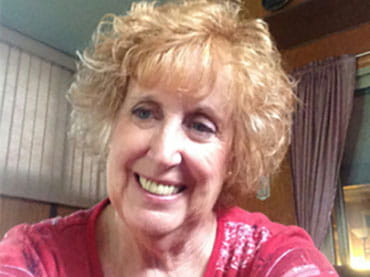Retiree Gets “Second Wind” After Lung Cancer Screening and Surgery
Mary Zanotto has a renewed zest for life.
It’s hard to believe it was only a few years ago the 70-year-old Plum Borough resident received news that would scare most. She had lung cancer.
The Challenge: Early Breathing Issues
In 2010, Mary sought treatment for a sore throat that wouldn't go away. Her doctors found lesions on her vocal cords and performed surgeries to remove them.
Mary had short-term relief. But after several years, her symptoms got worse. She was losing her voice, trying to manage the long-lasting cough, and at times, had trouble breathing.
Mary's doctors referred her to Ankur Puri, MD, a UPMC pulmonologist. He tested the strength of her lungs and looked for any underlying issues.
Tests found Mary — a long-time smoker — had chronic obstructive pulmonary disease (COPD). COPD is a lung condition often caused by damage to the lungs from smoking.
Dr. Puri ordered a low-dose CT scan, which can detect early-stage lung cancer. It also exposes people to less radiation than a regular CT scan.
Although she had smoked a pack of cigarettes a day for many years, Mary was hopeful. She felt her smoke-free lifestyle for more than a decade helped reduce any major harm to her lungs.
Unfortunately, doctors found that Mary had indeed developed lung cancer.
The Solution: Minimally Invasive Lung Surgery
Dr. Puri referred Mary to Nicholas Baker, MD, a thoracic surgeon at the UPMC Esophageal and Lung Surgery Institute.
Dr. Baker found she was a good candidate for surgery. He decided to perform video-assisted thoracoscopic surgery (VATS) to remove the upper right lobe of her right lung. Unlike an open surgery that requires a large cut in the chest and around the back, VATS is minimally invasive. Doctors use small incisions and a tiny camera to view the lungs.
Benefits of VATS often include less scarring, a lower risk of complications, faster healing, and a shorter hospital stay.
Thankfully, Dr. Baker found Mary had early stage 1a lung cancer that hadn't spread to her lymph nodes or other organs.
“My care team put me at ease. They explained everything in detail about this surgery and what they were going to do,” Mary says. “Dr. Baker was such a caring surgeon.”
Mary credits the UPMC Lung Cancer Screening Program for saving her life.
“I don’t think I’d be here today if it hadn’t been for the low-dose CT scan,” she says.
After surgery, it only took Mary a few months to recover. She feels healthy and finds walking up hills and steps much easier than before surgery.
Mary says, “Today, my quality of life is so much better. I didn’t realize before surgery how bad off I was, and now I see how good I feel.”
The Results: Good Health and Advocacy
Mary feels thankful to be in good health now and often reflects on someone very special to her.
“My mother died from lung cancer. I think, had this test been available when she was alive, she wouldn't have died in her 70s,” Mary says.
Since having the lung cancer screening and subsequent cancer treatment, Mary is enjoying retirement with her husband of 34 years. She’s doing things she loves, like traveling to Ohio to visit her son and granddaughter and going to Las Vegas with girlfriends.
She's also shared information with relatives and friends about the importance of the lung cancer screening test.
In addition to her loved ones, she has advice for any person with a long history of smoking.
“I would urge anyone who has ever smoked for a long time to ask their doctor about getting a low-dose CT scan.”



















